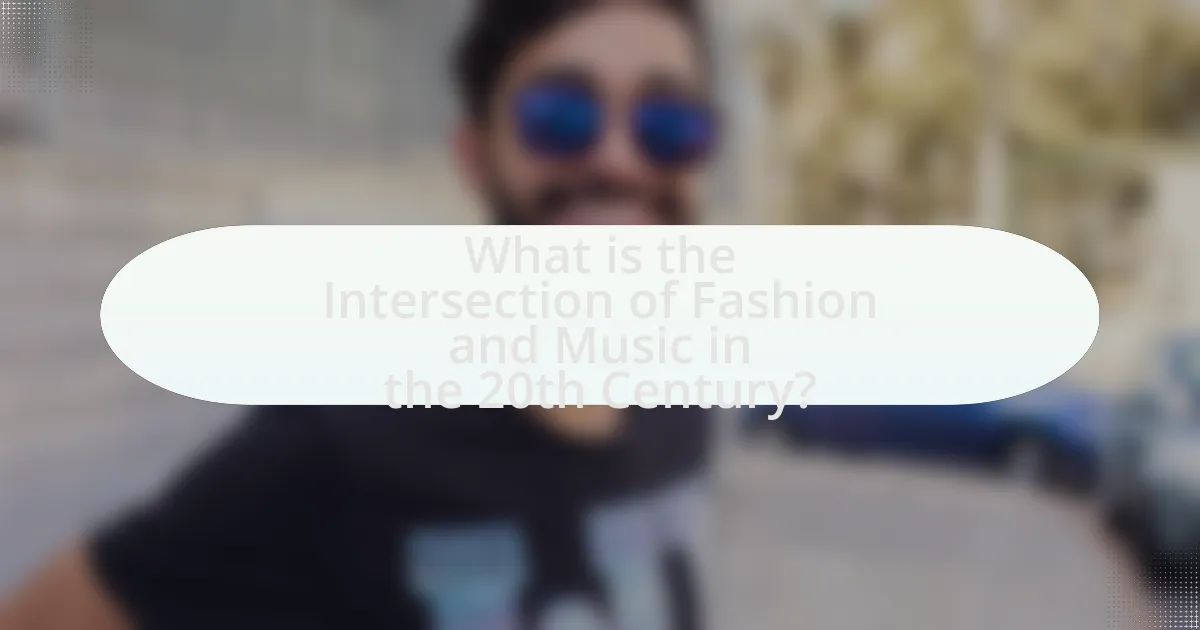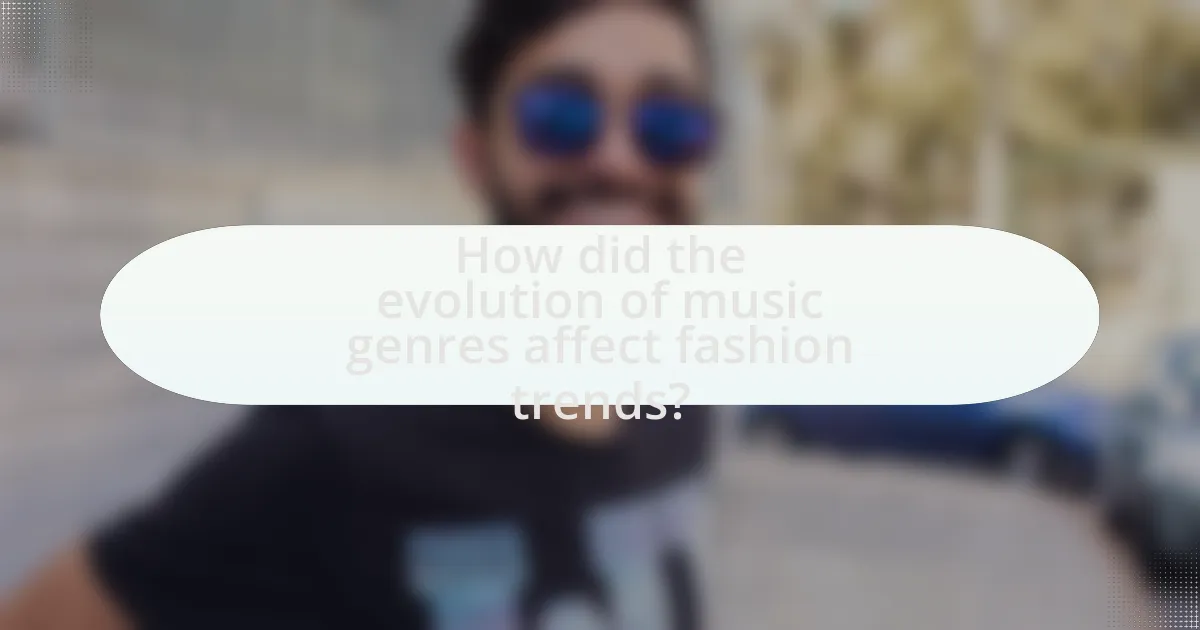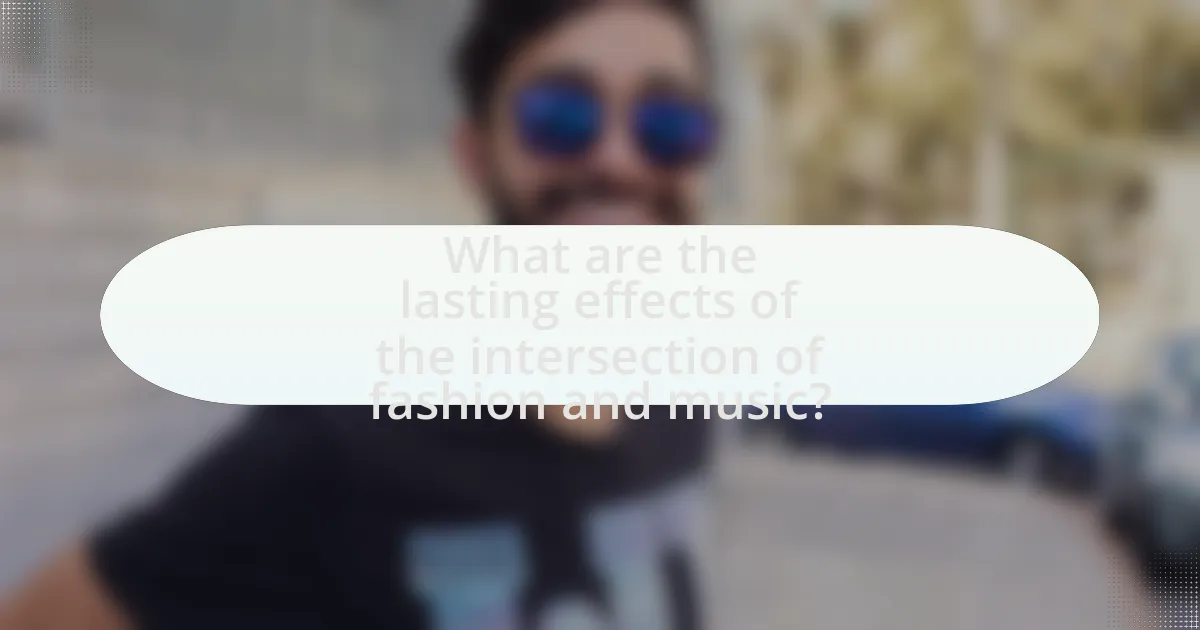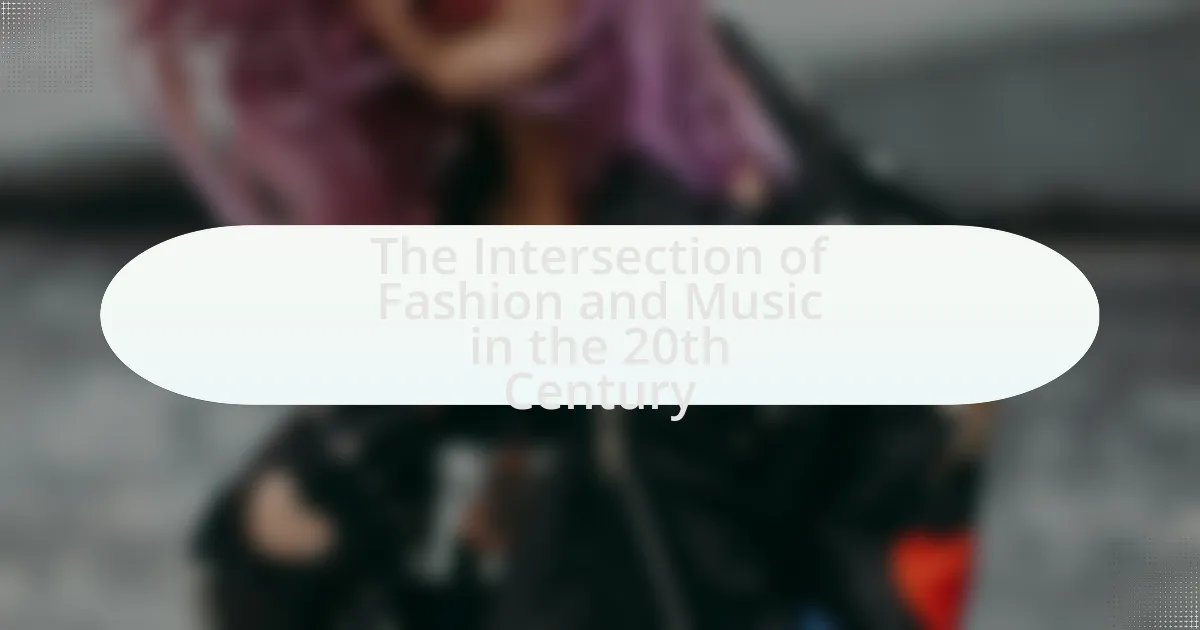The article explores the intersection of fashion and music in the 20th century, highlighting how musical genres influenced fashion trends and vice versa. It examines key movements such as rock and roll, punk, and hip-hop, detailing how iconic musicians like Madonna, David Bowie, and Prince shaped fashion through their unique styles and collaborations with designers. The article also discusses the impact of socio-political movements on fashion choices and the lasting effects of this dynamic relationship, illustrating how fashion and music serve as powerful vehicles for cultural expression and identity. Additionally, it addresses contemporary influences and best practices for emerging artists in leveraging fashion to enhance their musical identity.

What is the Intersection of Fashion and Music in the 20th Century?
The intersection of fashion and music in the 20th century is characterized by a reciprocal influence where musical genres shaped fashion trends and vice versa. For instance, the emergence of rock and roll in the 1950s led to the popularity of leather jackets and denim, as seen with icons like Elvis Presley and James Dean, who embodied this style. Similarly, the punk movement of the 1970s, represented by bands like the Sex Pistols, introduced a rebellious fashion aesthetic that included ripped clothing and bold hairstyles, influencing mainstream fashion designers. This dynamic relationship continued into the 1980s and 1990s, with hip-hop culture popularizing streetwear and brands like Adidas and FUBU becoming synonymous with the genre. The collaboration between musicians and fashion designers, such as Madonna’s partnership with Jean-Paul Gaultier, further exemplifies this intersection, showcasing how music not only influenced fashion choices but also became a platform for fashion innovation.
How did fashion and music influence each other during this period?
Fashion and music profoundly influenced each other during the 20th century, with each domain shaping trends and cultural movements. For instance, the emergence of rock and roll in the 1950s not only transformed music but also led to the popularization of leather jackets, denim, and rebellious styles that became synonymous with youth culture. Additionally, the disco era of the 1970s saw vibrant, flashy clothing styles that mirrored the upbeat, dance-centric music of the time, with artists like Donna Summer and the Bee Gees influencing fashion trends through their performances and music videos. This reciprocal relationship is evident in how musicians often set fashion trends, while designers drew inspiration from musical genres, creating a dynamic interplay that defined cultural identity throughout the century.
What key events marked the collaboration between fashion and music?
Key events that marked the collaboration between fashion and music include the 1960s British Invasion, where bands like The Beatles influenced fashion trends with their iconic styles, and the rise of punk in the 1970s, exemplified by bands like The Ramones, who popularized a rebellious aesthetic. Additionally, the 1980s saw the emergence of hip-hop culture, with artists like Run-D.M.C. collaborating with brands such as Adidas, solidifying the relationship between music and streetwear. The 1990s further showcased this collaboration through the grunge movement, led by bands like Nirvana, which brought thrift store fashion into mainstream culture. These events illustrate the significant impact of music on fashion trends throughout the 20th century.
How did cultural movements shape the relationship between fashion and music?
Cultural movements significantly shaped the relationship between fashion and music by creating distinct styles that reflected the values and attitudes of their time. For instance, the 1960s counterculture movement, characterized by anti-establishment sentiments, influenced musicians like Jimi Hendrix and bands like The Beatles, who adopted vibrant, eclectic fashion that symbolized freedom and rebellion. Similarly, the punk movement of the 1970s, with its emphasis on individuality and defiance, led to the emergence of styles such as leather jackets and ripped jeans, prominently worn by bands like The Sex Pistols. These movements not only dictated the aesthetics of music but also fostered a reciprocal influence where fashion became a visual representation of musical genres, thus intertwining the two fields in a dynamic cultural dialogue.
What role did iconic musicians play in shaping fashion trends?
Iconic musicians played a pivotal role in shaping fashion trends by using their public personas and performances to influence styles and consumer behavior. For instance, artists like David Bowie and Madonna not only defined their own unique looks but also set trends that resonated with fans, leading to widespread adoption of their styles. Bowie’s flamboyant costumes in the 1970s popularized glam rock fashion, while Madonna’s 1980s aesthetic, characterized by lace, layered clothing, and bold accessories, became emblematic of the era. These musicians often collaborated with designers, further bridging the gap between music and fashion, as seen in the partnerships between artists and brands like Jean-Paul Gaultier and Madonna. Their impact is evidenced by the lasting influence on fashion runways and retail, where elements of their styles continue to be referenced and revived in contemporary fashion.
Which musicians became fashion icons and why?
Madonna, David Bowie, and Prince became fashion icons due to their innovative styles and ability to influence cultural trends. Madonna’s bold fashion choices in the 1980s, such as lace gloves and layered jewelry, challenged gender norms and inspired a generation. David Bowie, particularly through his alter ego Ziggy Stardust, redefined gender expression and theatricality in fashion, making him a symbol of the glam rock movement. Prince’s flamboyant outfits and gender-fluid aesthetics in the 1980s showcased a unique blend of sexuality and artistry, influencing both music and fashion. Each of these musicians not only set trends but also used their fashion to convey messages about identity and self-expression, solidifying their status as fashion icons.
How did musicians use fashion as a form of self-expression?
Musicians used fashion as a form of self-expression by adopting distinctive styles that reflected their identities, beliefs, and the cultural movements of their time. For instance, artists like David Bowie and Madonna utilized flamboyant costumes and bold aesthetics to challenge societal norms and convey messages about gender and sexuality. The punk rock movement in the 1970s showcased musicians like Sid Vicious, who wore ripped clothing and safety pins to symbolize rebellion against mainstream culture. Additionally, hip-hop artists in the 1980s and 1990s, such as Run-D.M.C., popularized streetwear, which became a representation of urban identity and resistance. These fashion choices not only defined their personal brands but also influenced broader cultural trends, demonstrating the powerful connection between music and fashion as vehicles for self-expression.
What impact did fashion designers have on the music industry?
Fashion designers significantly influenced the music industry by shaping artists’ public personas and enhancing their visual appeal. Designers like Yves Saint Laurent and Vivienne Westwood created iconic looks that became synonymous with musical movements, such as glam rock and punk. For instance, David Bowie’s collaboration with designer Kansai Yamamoto in the 1970s resulted in groundbreaking stage costumes that redefined performance aesthetics. Additionally, the rise of hip-hop culture saw designers like Karl Lagerfeld and Ralph Lauren partnering with artists, further merging fashion with music. This collaboration not only elevated the status of musicians but also transformed fashion into a vital component of musical identity and expression.
Which designers collaborated with musicians to create memorable looks?
Designers such as Jean-Paul Gaultier, Alexander McQueen, and Versace collaborated with musicians to create memorable looks. Jean-Paul Gaultier designed iconic outfits for Madonna, including the famous cone bra worn during her 1990 Blonde Ambition World Tour. Alexander McQueen created striking ensembles for artists like Björk, notably the swan dress she wore at the 2001 Oscars. Versace’s collaboration with artists like Jennifer Lopez resulted in the unforgettable green jungle dress she wore to the 2000 Grammy Awards, which became a cultural phenomenon. These collaborations exemplify the significant impact of fashion in the music industry during the 20th century.
How did fashion designers influence the visual identity of music genres?
Fashion designers significantly influenced the visual identity of music genres by creating iconic styles that became synonymous with specific musical movements. For instance, the punk rock movement of the 1970s was heavily shaped by designers like Vivienne Westwood, whose designs featured ripped clothing, safety pins, and bold graphics, reflecting the rebellious spirit of the genre. Similarly, the glam rock era saw designers like David Bowie adopting flamboyant costumes that emphasized theatricality and androgyny, which became defining characteristics of the genre. The hip-hop genre also saw a transformation in its visual identity through the influence of designers such as Karl Kani and Dapper Dan, who popularized oversized clothing and luxury brand collaborations, establishing a unique aesthetic that resonated with the culture. These examples illustrate how fashion designers not only contributed to the aesthetics of music genres but also helped to communicate the cultural and social messages inherent in the music itself.

How did the evolution of music genres affect fashion trends?
The evolution of music genres significantly influenced fashion trends by shaping cultural identities and social movements. For instance, the rise of rock and roll in the 1950s introduced leather jackets and denim, symbolizing rebellion and youth culture. Similarly, the emergence of punk music in the 1970s brought about a distinctive style characterized by ripped clothing, safety pins, and bold hairstyles, reflecting anti-establishment sentiments. Additionally, hip-hop culture in the 1980s popularized streetwear, including oversized clothing and athletic shoes, which became mainstream fashion. These shifts illustrate how music genres not only reflect societal changes but also actively shape fashion choices, creating a dynamic interplay between the two cultural expressions.
What are the key music genres that influenced fashion in the 20th century?
The key music genres that influenced fashion in the 20th century include jazz, rock and roll, punk, and hip-hop. Jazz, emerging in the 1920s, introduced a sense of sophistication and style, influencing flapper dresses and tailored suits. Rock and roll, gaining prominence in the 1950s, led to the popularity of leather jackets and denim, symbolizing rebellion and youth culture. Punk music in the 1970s brought about a radical shift, characterized by ripped clothing, safety pins, and bold hairstyles, reflecting anti-establishment sentiments. Finally, hip-hop, which rose in the 1980s, popularized streetwear, oversized clothing, and athletic brands, shaping urban fashion trends. Each genre not only defined musical styles but also left a lasting impact on the fashion landscape of their respective eras.
How did rock and roll fashion differ from punk fashion?
Rock and roll fashion primarily emphasized a polished, glamorous aesthetic characterized by leather jackets, tight jeans, and flashy accessories, reflecting the rebellious yet commercial nature of the genre. In contrast, punk fashion was defined by its raw, anti-establishment ethos, featuring ripped clothing, DIY elements, and bold statements through accessories like studs and safety pins, which symbolized a rejection of mainstream culture. The differences are rooted in their respective cultural contexts; rock and roll emerged in the 1950s and 1960s, often associated with youth rebellion but still maintaining a sense of style, while punk emerged in the 1970s as a direct response to societal norms, prioritizing individuality and a confrontational attitude over traditional fashion standards.
What elements of hip-hop culture influenced streetwear fashion?
Hip-hop culture significantly influenced streetwear fashion through its emphasis on individuality, urban aesthetics, and music-driven trends. The rise of hip-hop in the late 1970s and 1980s introduced styles such as oversized clothing, graphic tees, and sneakers, which became staples in streetwear. Artists like Run-D.M.C. popularized Adidas sneakers, while brands like FUBU and Phat Farm emerged, reflecting the culture’s values of self-expression and community identity. The integration of hip-hop elements into streetwear is evident in collaborations between fashion designers and hip-hop artists, further solidifying the genre’s impact on contemporary fashion.
How did socio-political movements impact fashion and music?
Socio-political movements significantly influenced fashion and music by serving as catalysts for cultural expression and identity. For instance, the Civil Rights Movement in the 1960s inspired artists like Nina Simone and James Brown to incorporate themes of racial and social justice into their music, which resonated with the fashion of the time, characterized by bold colors and styles that reflected African American culture. Similarly, the feminist movement led to the rise of androgynous fashion and music, with artists like David Bowie challenging traditional gender norms, thereby reshaping societal perceptions of identity. The punk movement of the 1970s further exemplified this impact, as its anti-establishment ethos was expressed through both music and fashion, with bands like The Sex Pistols using their style and sound to critique political issues. These examples illustrate how socio-political movements have historically intertwined with fashion and music, driving change and reflecting the zeitgeist of their respective eras.
What role did the civil rights movement play in shaping fashion choices?
The civil rights movement significantly influenced fashion choices by promoting African American cultural and identity. Activists used clothing as a form of expression, showcasing traditional African attire and styles that celebrated their heritage, which contrasted with mainstream fashion norms. For instance, the adoption of the Afro hairstyle and colorful, bold clothing during the 1960s symbolized resistance against racial oppression and a reclaiming of cultural identity. This shift in fashion was evident in the styles of prominent figures like Angela Davis and the Black Panther Party, who used their attire to convey political messages and solidarity. The movement’s emphasis on self-empowerment and cultural led to a lasting impact on fashion, encouraging diversity and inclusivity in the industry.
How did counterculture movements influence mainstream fashion trends?
Counterculture movements significantly influenced mainstream fashion trends by introducing alternative styles that challenged societal norms. For instance, the 1960s hippie movement popularized vibrant colors, tie-dye fabrics, and bohemian silhouettes, which later permeated mainstream fashion through designers like Yves Saint Laurent and brands like Gap. Additionally, punk culture in the 1970s brought elements such as leather jackets, ripped jeans, and DIY aesthetics into the fashion lexicon, leading to widespread adoption by major retailers. These movements not only reflected the values of rebellion and individuality but also reshaped consumer preferences, making once-radical styles accessible and desirable to the general public.

What are the lasting effects of the intersection of fashion and music?
The lasting effects of the intersection of fashion and music include the establishment of iconic styles that define cultural movements and influence consumer behavior. For instance, the punk rock movement of the 1970s not only shaped music but also introduced a distinct fashion aesthetic characterized by leather jackets, ripped jeans, and DIY elements, which continue to inspire contemporary fashion designers. Additionally, the collaboration between musicians and fashion brands, such as Rihanna’s partnership with Puma, demonstrates how music artists can drive trends and create significant economic impact in the fashion industry. This synergy has led to a continuous cycle where fashion and music mutually influence each other, shaping identities and cultural expressions across generations.
How do contemporary artists draw inspiration from 20th-century fashion and music?
Contemporary artists draw inspiration from 20th-century fashion and music by incorporating iconic styles, motifs, and cultural references into their work. For instance, the bold colors and patterns of 1960s pop art, influenced by the vibrant fashion of that era, can be seen in the works of artists like Yayoi Kusama. Additionally, the fusion of music genres, such as punk and hip-hop, has led to visual art that reflects the rebellious spirit and aesthetic of those movements, as evidenced by artists like Jean-Michel Basquiat, who integrated elements of street culture and music into his paintings. This connection is further supported by the resurgence of vintage fashion trends in contemporary design, showcasing how past styles continue to inform current artistic expressions.
What current fashion trends can be traced back to 20th-century music icons?
Current fashion trends such as oversized silhouettes, graphic tees, and punk aesthetics can be traced back to 20th-century music icons like Kurt Cobain, Madonna, and David Bowie. Kurt Cobain popularized grunge fashion, characterized by baggy flannel shirts and distressed jeans, which remains influential today. Madonna’s bold use of lace, corsets, and layered accessories in the 1980s set the stage for contemporary streetwear and high-fashion mashups. David Bowie’s flamboyant styles, including androgynous outfits and vibrant colors, continue to inspire gender-fluid fashion trends. These connections illustrate how the styles of these music legends have shaped modern fashion sensibilities.
How has the digital age transformed the relationship between fashion and music?
The digital age has transformed the relationship between fashion and music by enabling instant access to trends and fostering collaboration across platforms. Social media platforms like Instagram and TikTok allow artists and designers to showcase their work to a global audience, leading to rapid dissemination of styles and influences. For instance, the rise of fashion influencers and musicians who share their outfits and music videos has blurred the lines between the two industries, creating a symbiotic relationship where fashion trends often emerge from music culture. Additionally, streaming services have changed how music is consumed, allowing for curated playlists that often feature fashion-forward visuals, further intertwining the two realms. This transformation is evidenced by the significant increase in fashion collaborations with musicians, such as Rihanna’s Fenty line and Beyoncé’s Ivy Park, which highlight the merging of music and fashion in the digital landscape.
What lessons can be learned from the intersection of fashion and music in the 20th century?
The intersection of fashion and music in the 20th century teaches that cultural movements are often intertwined, influencing societal norms and individual expression. For instance, the rise of rock ‘n’ roll in the 1950s not only transformed music but also led to a shift in fashion, with leather jackets and denim becoming symbols of rebellion. Additionally, the punk movement in the 1970s showcased how music could challenge fashion norms, as artists like the Sex Pistols used their style to convey anti-establishment messages. This synergy illustrates that fashion and music serve as powerful vehicles for identity and social commentary, shaping trends and reflecting the zeitgeist of their respective eras.
How can emerging artists leverage fashion to enhance their musical identity?
Emerging artists can leverage fashion to enhance their musical identity by using distinctive clothing styles to create a visual representation of their brand. This approach allows them to communicate their artistic vision and connect with their audience on a deeper level. For instance, artists like David Bowie and Madonna utilized fashion as a key element of their personas, which contributed significantly to their popularity and cultural impact. Research indicates that visual aesthetics in music can influence listener perceptions and emotional responses, reinforcing the idea that fashion is not merely an accessory but a vital component of an artist’s identity. By curating a unique fashion sense that aligns with their musical themes, emerging artists can differentiate themselves in a competitive industry and foster a loyal fan base.
What best practices can be adopted from past collaborations between fashion and music?
Best practices from past collaborations between fashion and music include creating cohesive branding, leveraging celebrity influence, and utilizing multimedia platforms for promotion. Cohesive branding ensures that the visual identity of fashion aligns with the musical style, as seen in the partnership between David Bowie and designer Kansai Yamamoto, which created a distinct aesthetic that resonated with audiences. Leveraging celebrity influence is exemplified by the collaboration between Rihanna and Puma, where Rihanna’s status in music significantly boosted the brand’s visibility and sales. Utilizing multimedia platforms for promotion is evident in the success of music videos that showcase fashion, such as Beyoncé’s “Formation,” which not only highlighted her music but also featured prominent fashion elements, driving trends and sales. These practices demonstrate effective strategies that can enhance the impact of collaborations between the two industries.

Leave a Reply